```
nyuto onsen akita is a cluster of seven historic hot spring inns hidden in the mountains of Semboku City, Akita. People come for milky hot water, wooden bathhouses, and serene forests. The area is quiet, snow-heavy in winter, and run by small family-style ryokan. This guide uses plain English so you can plan without stress: how to get there, how the bath-hopping pass works, when to go, what to do, and where to stay. You will also find an easy model itinerary and useful phrases for the baths. All key numbers—price, time, distance—are highlighted so you can decide quickly. We also include Japanese official links for accuracy, because many local details (bus times, day-use hours) change seasonally in Tohoku. If you love the idea of “bath hopping,” this is one of the best places in Japan to try it—calm, natural, and deeply local.
Table of Contents
1. Why is Nyuto Onsen worth your time?
2. How can you get there efficiently?
3. What are the best things to do?
4. Where should you eat and stay?
6. What’s next? Tips, phrases, and FAQs
1. Why is Nyuto Onsen worth your time?
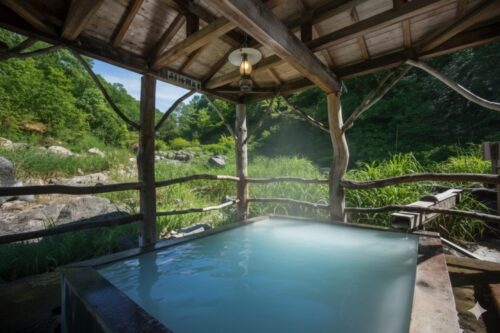
1-1 Nyuto in plain English
Nyuto Onsenkyo sits near Lake Tazawa in Semboku City (Akita Prefecture). The inns are spread through forest roads and each ryokan has its own mineral mix, outdoor baths, and character. You come to slow down—walk between baths, nap, and enjoy simple mountain food. If you search “nyuto onsen in akita,” you will see snow scenes, milky water, and dark timber buildings—this is the real vibe.
Key idea: it is a small-capacity destination. Day visitors can be refused when full. Overnight guests always have priority. For official area info, see the Nyuto Onsenkyo site: Official website (Japanese).
1-2 How the bath-hopping concept works
You can pay individual day-use fees at each ryokan or use a multi-bath pass (Yumeguri). Typical day-use slots are late morning to mid-afternoon, not evenings. Expect ~10:00–15:00 for many inns (varies), and expect closures when the bath is cleaned or the inn is too busy.
Pass details are published by the Nyuto Onsenkyo association; check the latest rules and participating inns here: Official website (Japanese).
1-3 The onsen pass in one glance
The Yumeguri pass (湯めぐり帖) usually covers several day baths across the Nyuto group within a validity period. Typical price range: ¥1,800–¥2,500. Typical contents: 3 baths, valid for about 6 months. Always confirm current terms: Official website (Japanese).
2. How can you get there efficiently?
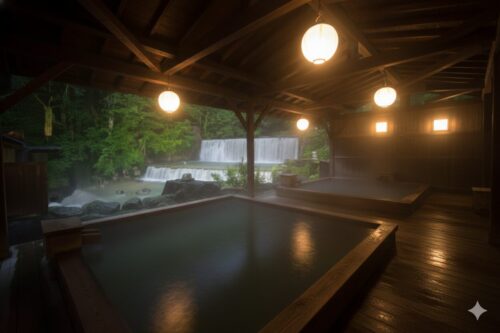
2-1 From Tokyo and major cities
Take the Akita Shinkansen (Komachi) to Tazawako Station. Typical journey: ~2h40m–3h from Tokyo Station; standard reserved seat one-way is around ¥14,000–¥18,000 depending on date and seat type. Check JR East for exact trains and fares: Official website (Japanese).
2-2 Bus and last-mile to the baths
From Tazawako Station, use the Ugo Kotsu bus (Nyuto line) to the various inns. Typical ride: ~40–50 minutes; fare commonly about ¥900–¥1,200 one-way depending on stop. See Ugo Kotsu: Official website (Japanese). Taxis are available and may take ~30–40 minutes, costing roughly ¥7,000–¥10,000 depending on weather and routing.
Distance Tazawako → Nyuto core: approximately 18–22 km. In deep winter, roads are snowy; allow buffer time.
2-3 Quick Access & Time table
Use this summary to plan connections. Always verify details on the official sites.
Table 1: Access & Time Summary
| Leg | Typical Time | Typical Cost | Official Link (JP) |
|---|---|---|---|
| Tokyo → Tazawako (Akita Shinkansen) | ~2h40m–3h | ¥14,000–¥18,000 (reserved seat, one-way) | Official website (Japanese) |
| Tazawako Station → Nyuto (bus) | ~40–50 minutes | ¥900–¥1,200 (one-way) | Official website (Japanese) |
| Taxi (Tazawako → Nyuto) | ~30–40 minutes | ¥7,000–¥10,000 | Official website (Japanese) |
* Times and fares vary by date and season. Check the Official website for updates.
3. What are the best things to do?
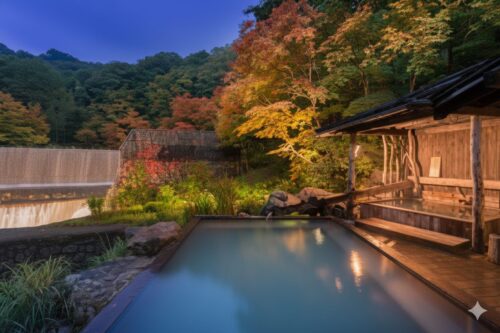
3-1 Iconic baths and what to expect
Each ryokan is different: classic wooden structures, milky mineral tones, mixed or gender-separate baths, and varying day-use hours. Tsurunoyu is the most famous, often crowded; others like Taenoyu, Kuroyu, Ganiba, Magoroku, Ogama, and Kyukamura offer quieter corners. Always check current day-use rules on the association site: Official website (Japanese).
3-2 Easy nature time around Lake Tazawa
Between baths, walk short forest paths, or take a bus or taxi down to Lake Tazawa for a lakeside stroll and the golden Tatsuko statue. Local tourism info and maps are available here: Official website (Japanese).
3-3 Seasonal magic (snow, foliage, quiet)
Winter (Dec–Mar) brings steam and snow pillows around outdoor baths—spectacular but cold. Autumn (Oct) gives foliage and crisp air. Shoulder seasons are quieter. For weather and seasonal notices, see Semboku tourism: Official website (Japanese).
4. Where should you eat and stay?
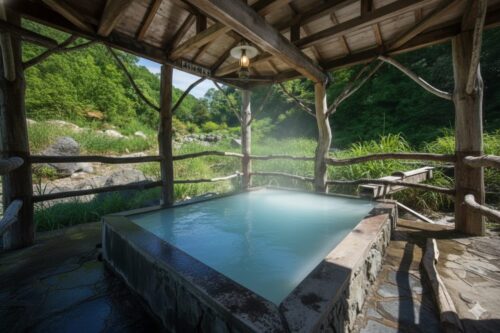
4-1 Choosing your ryokan
If it’s your first time, pick one stay night for a slow pace, then add day baths with a pass. Kyukamura Nyuto Onsenkyo is a nature-lodge style with easier availability; classic inns are smaller and can sell out. See official pages via the association: Official website (Japanese) and Kyukamura: Official website (Japanese).
4-2 Day-use baths and simple meals
Many inns offer day-use bathing for a small fee. Typical per-bath price is ¥600–¥1,200 per adult; hours often end by 15:00–16:00. Some offer set lunches or local dishes. Check the specific inn’s Japanese page via the association: Official website (Japanese).
4-3 Budget snapshot (rooms, meals, pass)
Use this as a rough planning yardstick; verify rates before booking.
Table 2: Budget & Ticket Prices
| Item | Typical Price / Eligibility | Official Link (JP) |
|---|---|---|
| Yumeguri (Onsen Pass) | ¥1,800–¥2,500; typical content 3 baths; validity ~6 months; for 1 person, non-transferable | Official website (Japanese) |
| Day-use bath (per inn) | ¥600–¥1,200 adult; typical hours ~10:00–15:00; capacity controlled | Official website (Japanese) |
| Ryokan with dinner & breakfast | ¥15,000–¥28,000 pppn in peak; more value off-peak; child policies vary | Official website (Japanese) |
* Prices vary by season, room type, and meal plan. Confirm on each inn’s Official website before payment.
5. What itinerary works best?
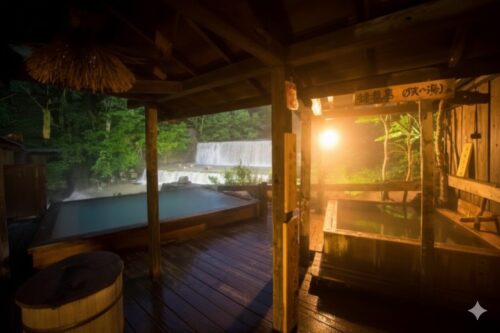
5-1 Model day trip (Tokyo ⇄ Nyuto)
Catch an early Komachi to Tazawako, bus up to Nyuto, bath-hop with a pass, and return in the evening.
5-2 Model overnight (slow snow escape)
Arrive before lunch, soak at 1–2 inns, check in, enjoy dinner and night baths, then 2–3 more next morning before heading back.
5-3 The itinerary table (edit to your timings)
Table 3: Model Itinerary
| Time | Activity | Details (JP Official Links) |
|---|---|---|
| 07:32 | Komachi from Tokyo → Tazawako | Akita Shinkansen (~2h40m–3h). Official website (Japanese) |
| 10:20 | Bus to Nyuto Onsenkyo | Ugo Kotsu Nyuto line (~40–50 minutes). Official website (Japanese) |
| 11:15 | Buy Yumeguri pass & first bath | Pass ~¥1,800–¥2,500. Official website (Japanese) |
| 12:30 | Simple lunch at an inn (if offered) | Check menus/hours locally. Official website (Japanese) |
| 13:30 | Second bath (quiet option) | Choose a less busy ryokan. Official website (Japanese) |
| 15:00 | Third bath or Lake Tazawa stop | Check bus times back. Official website (Japanese) |
| 18:30–20:00 | Train back to Tokyo (or stay overnight) | Evening Komachi. Official website (Japanese) |
* Times are examples. Check the Official website for updates.
6. What’s next? Tips, phrases, and FAQs

6-1 Seasonal calendar & crowd signal
Use this at a glance. “Crowd” is a simple travel signal (low/med/high).
Table 4: Seasonal Calendar (Best Season & Crowds)
| Month | What to Expect | Crowd |
|---|---|---|
| Jan–Mar | Deep snow, iconic steam scenes; allow +20–30 minutes for travel buffers | Medium–High |
| Apr–May | Thaw and spring greens; quieter weekdays | Low–Med |
| Jun–Aug | Cool forests; occasional rain; good for hikers | Med |
| Sep–Oct | Autumn foliage; book early for weekends | High |
| Nov–Dec | Pre-snow quiet to first snowfall; chilly nights | Low–Med |
* Festival dates and weather change yearly; confirm via Semboku tourism’s Japanese pages.
6-2 Etiquette & eligibility (simple version)
- Wash before soaking; towels stay out of the water.
- Some baths are mixed; if unsure, choose gender-separate areas.
- Passes are for 1 person only; private baths (kashikiri) usually not included.
- Tattoos: rural Tohoku is generally relaxed, but policies vary—ask at reception.
- Day-use can close early when full; overnight guests get priority.
Rules and eligibility vary by inn; check the Japanese association page or each ryokan’s site: Official website (Japanese).
6-3 Useful phrases for the baths
- Higaeri nyūyoku wa arimasu ka? — “Do you offer day-use bathing?”
- Yumeguri chō wa doko de kaemasu ka? — “Where can I buy the bath-hopping pass?”
- Nyūyoku jikan wa? — “What are the bathing hours?”
- Senjōjo wa doko desu ka? — “Where is the washing area?”
- Kashikiri rotenburo wa arimasu ka? — “Is there a private open-air bath?”
6-4 FAQs about Nyuto (bath pass, access, seasons)
Q1. Is the nyuto onsen pass worth it?
A. If you plan 3 baths in one day, yes—the pass usually pays off compared with single-entry fees. Check prices on the association site: Official website (Japanese).
Q2. How do I reach nyuto akita in winter?
A. Shinkansen to Tazawako, then the Ugo Kotsu bus. Add a buffer of +20–30 minutes in snow and confirm the last return bus that day: Official website (Japanese).
Q3. What is nyuto onsen in akita like for first-timers?
A. It’s rustic and quiet. Expect limited day-use hours (~10:00–15:00) and small changing rooms. Bring cash and your own small towel. See area details: Official website (Japanese).
Q4. Can I bathe with tattoos?
A. Often fine in rural Tohoku, but always ask. If requested, cover with a patch or choose a private bath if available. Policies differ by inn: Official website (Japanese).
6-5 Recommended reads on Japan Travel (internal)
- Tokyo 3-Day Itinerary (first-time plan)
- Akita Winter Travel Guide
- Lake Tazawa Day Trip: Views & Cafes
- Tohoku Onsen Road Trip (car-free options)
```